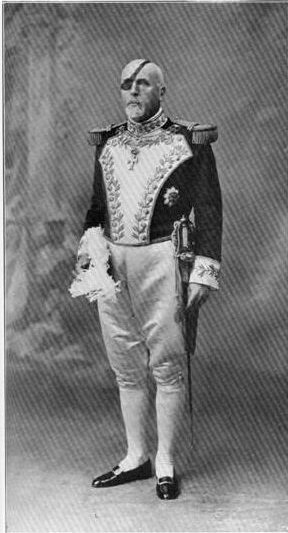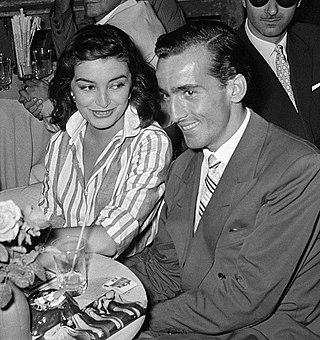
Castello Ruspoli is a 16th-century castle in the town of Vignanello, Lazio, Italy. It continues to be the property of the Ruspoli family, an old and noble Italian family. It is well known for its Renaissance-era Giardino all'italiana .

Castello Ruspoli is a 16th-century castle in the town of Vignanello, Lazio, Italy. It continues to be the property of the Ruspoli family, an old and noble Italian family. It is well known for its Renaissance-era Giardino all'italiana .
In 1531, Pope Clement VII awarded Vignanello as a fief to Beatrice Farnese. Her daughter, Ottavia, married Sforza Marescotti, and the Farnese Pope Paul III confirmed the fief and elevated the couple to the first count and countess of Vignanello. The castle was built around 1574 as the seat of the count and countess, elaboration was attributed to Jacopo Barozzi da Vignola. [1] In the 17th century the Renaissance gardens were created by Ottavia Orsini who had married into the family. The gardens still stand and are one of the best preserved examples of an Italian Renaissance garden. [2] The castle contains on the ground floor a chapel dedicated to Sister Giacinta, a Ruspoli family member who was canonized a Saint by Pope Pius VII in 1807.
The Ruspoli family was an influential Italian noble family with close connections to the Holy See. Francesco Maria Ruspoli, the 6th Count of Vignanello, was made the 1st Prince of Cerveteri, and the family has used the Princely title ever since. Many generations of the family lived at the castle in Vignanello, although the family had residences in Rome and Cerveteri as well. The castle continues to be in the possession of the Ruspoli family and serves as a private residence, but is open for visits and events. [3]

The House of Orsini is an Italian noble family that was one of the most influential princely families in medieval Italy and Renaissance Rome. Members of the Orsini family include five popes: Stephen II (752–757), Paul I (757–767), Celestine III (1191–1198), Nicholas III (1277–1280), and Benedict XIII (1724–1730). In addition, the family included 34 cardinals, numerous condottieri, and other significant political and religious figures.

The Villa Farnese, also known as Villa Caprarola, is a pentagonal mansion in the town of Caprarola in the province of Viterbo, Northern Lazio, Italy, approximately 50 kilometres (31 mi) north-west of Rome. This villa should not be confused with the Palazzo Farnese and the Villa Farnesina, both in Rome. A property of the Republic of Italy, Villa Farnese is run by the Polo Museale del Lazio.

Bracciano is a small town in the Italian region of Lazio, 30 kilometres northwest of Rome. The town is famous for its volcanic lake and for a particularly well-preserved medieval castle Castello Orsini-Odescalchi. The lake is widely used for sailing and is popular with tourists; the castle has hosted a number of events, especially weddings of actors and singers.

The Grand Master of the Sacred Apostolic Hospice or Quartermaster-General of the Sacred Palaces is a hereditary official of the Pontifical Household. The title and office became hereditary on June 28, 1808, when Pope Pius VII appointed Prince Francesco Ruspoli as Grand Master.
Pier Francesco Orsini, also called Vicino Orsini, was an Italian condottiero, patron of the arts, and duke of Bomarzo. He is famous as the commissioner of the Mannerist Park of the Monsters in Bomarzo.

The Castle of Canossa is a castle in Canossa, province of Reggio Emilia, northern Italy.

The House of Ruspoli is historically one of the great aristocratic families of Rome, but is originally from Florence. Following World War II and the fall of Fascism, the newly established Italian Republic officially abolished titles and hereditary honours in its 1946 Constitution, with the exception of the papal nobility of Rome, as those titles had been created by papal authority.

Alessandro "Dado"Ruspoli, 9th Prince of Cerveteri was an occasional actor and a playboy and eccentric aristocrat, the 9th Principe di Cerveteri, 9th Marchese di Riano, 14th Conte di Vignanello and Prince of the Roman Papal States. Dado descends from a brother of Cardinal Bartolomeo Ruspoli.

Francesco, Prince Ruspoli, 3rd Prince of Cerveteri, 3rd Marquis of Riano, 8th Count of Vignanello was the 3rd Prince of Cerveteri, 3rd Marquis of Riano and 8th Count of Vignanello, son of Alessandro Ruspoli, 2nd Prince of Cerveteri and second wife and first cousin Prudenza dei Conti Marescotti-Capizucchi. His uncle was Bartolomeo Ruspoli.

Don Francesco Maria Marescotti, Principe Ruspoli was the ?th Marchese and 1st Principe di Cerveteri, 1st Marchese di Riano and 6th Conte di Vignanello.

The House of Khevenhüller is the name of an old and important Carinthian noble family, documented there since 1356, with its ancestral seat at Landskron Castle. In the 16th century, the family split into the two branches of Khevenhüller-Frankenburg, Imperial Counts from 1593, and Khevenhüller-Hochosterwitz, raised to Imperial Counts in 1725 and, as Khevenhüller-Metsch, to princely rank (Fürsten) in 1763. The family belongs to high nobility.

Aure soavi e liete is a Baroque dramatic secular cantata in the key of E-flat major composed by George Frideric Handel in 1707 while he was serving as Kapellmeister to the Ruspoli family in Rome. The author of the text is unknown. Other catalogues of Handel's music have referred to the work as HG l,12. The cantata is scored for solo soprano voice and basso continuo. It is divided into four separate movements with a typical performance lasting approximately seven and a half minutes.

Castello Orsini-Odescalchi is a castle in Bracciano, Lazio, Italy. It is located on the southern shore of Lake Bracciano. It was built in the 15th century, and combines the functions of a military defence structure and a civilian residence of the feudal lords of the period, the Orsini and Borgia, both papal families. As one of the largest and best-maintained castles in Italy, it also houses a museum; as a centre of cultural events, the Castello has hosted several high-profile weddings such as those of Tom Cruise/Katie Holmes, Eros Ramazzotti/Michelle Hunziker, and Petra Ecclestone/James Stunt.

The papal nobility are the aristocracy of the Holy See, composed of persons holding titles bestowed by the Pope. From the Middle Ages into the nineteenth century, the papacy held direct temporal power in the Papal States, and many titles of papal nobility were derived from fiefs with territorial privileges attached. During this time, the Pope also bestowed ancient civic titles such as patrician. Today, the Pope still exercises authority to grant titles with territorial designations, although these are purely nominal and the privileges enjoyed by the holders pertain to styles of address and heraldry. Additionally, the Pope grants personal and familial titles that carry no territorial designation. Their titles being merely honorific, the modern papal nobility includes descendants of ancient Roman families as well as notable Catholics from many countries. All pontifical noble titles are within the personal gift of the pontiff, and are not recorded in the Official Acts of the Holy See.
Camilo Ruspoli y Khevenhüller-Mestch, dei principi Ruspoli, Duke of Sueca and Prince of the Holy Roman Empire, was an Italian aristocrat, son-in-law of Manuel Godoy.
The Duchy of Bracciano was a fief of the Papal States, centred on lago di Bracciano and the town of Bracciano itself and ruled by a branch of the Orsini family with the title of Lord and Duke (1560–1696).

Duke of Sueca is a title of Spanish nobility, Grandee of Spain 1st class. It was created by King Charles IV of Spain in 1804 for Manuel Godoy, who was the Prime Minister of Spain from 1792 to 1797 and from 1801 to 1808. Its name refers to Sueca in the Province of Valencia in Spain.

The Castle of San Michele, once known as the Castel di Piero, was built in the Lazio region of Italy during the 12th century. It is located in the village of San Michele in Teverina, Civitella d'Agliano, Viterbo.

The Cesi family is an Italian noble family which belonged to the high aristocracy of Rome and the Papal States.
DonnaMathilda Mélusine dei Principi Ruspoli, also known as Princess Melusine Ruspoli, is French-born Italian socialite, model, and fashion influencer. She is the daughter of Alessandro Ruspoli, 9th Prince of Cerveteri and a member of the House of Ruspoli, an Italian noble family with close ties to the Vatican that was elevated into the Black nobility. Ruspoli made her modelling debut in 2014 as one of the faces of Salvatore Ferragamo S.p.A.'s Fiamma campaign. She made her runway debut for walking for Dolce & Gabbana at Milan Fashion Week in 2017.